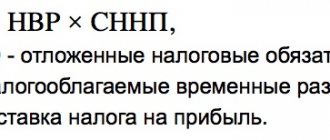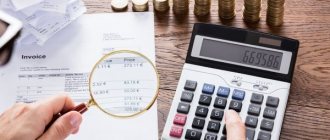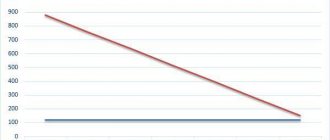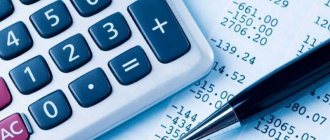Determining the useful life of intangible assets and calculating depreciation
You can take into account the costs of intangible assets by calculating depreciation, which allows you to transfer the cost of the asset to finished products. In this case, it will be necessary to determine the method of accrual and useful life.
Note. It is not always possible to accurately determine the period, then the asset will become perpetual. In this case, no depreciation will be generated.
For other objects, depreciation will be calculated monthly using one of the following methods (clause 15 of PBU 14/2007):
Depreciation of intangible assets is formed from the 1st day of the month following the month of commissioning.
Example 1.
If intangible assets are accepted on the balance sheet on February 25, 2021, then depreciation will begin on March 1, 2021.
With the straight-line method, the value of assets will be written off evenly every month. Depreciation charges will always be equal.
Example 2.
The initial cost of intangible assets is 150,000 rubles. The company has established a useful life of 36 months. The monthly depreciation amount will be calculated:
Accordingly, 4,166.67 rubles will be written off monthly for expenses.
The reducing balance method involves using residual value to calculate depreciation. In this case, deductions each month will have to be determined minus similar expenses for the previous month.
Example 3.
The initial cost of intangible assets is 150,000 rubles. The company expects to use the facility for 36 months with an acceleration factor of 2. The date of commissioning is 09/28/2019. Then:
Accordingly, each subsequent month the amount of deductions will be lower.
If in an organization there is a relationship between intangible assets and the quantity of products produced, it is possible to use the method of writing off the cost in proportion to the volume of products (works). To apply this method, you need to know the planned and actual output.
Example 4.
The initial cost of the object is 150,000 rubles. The period of use is 36 months. During this period, thanks to the use of intangible materials, it is planned to produce 760 units of finished products. Commissioning took place on September 28, 2019. The actual volume of production for October was 13 units, for November – 25, December – 41.
When choosing this method, we are not interested in the useful life itself in months, but in the quantity of products produced during this period. Deductions:
As for tax accounting, here, as for fixed assets, only 2 methods are used: linear and nonlinear.
Depreciation in tax accounting is charged on an asset whose value exceeds 100,000 rubles. In the event that the payment of the cost of intangible assets to the supplier was not made immediately, but is carried out in periodic payments during the period of validity of the contract with the counterparty, depreciation is not accrued. In this case, as funds are accepted onto the balance sheet, the cost of the asset will be written off as other expenses.
Methods and methods for calculating depreciation of intangible assets
Intangible assets (hereinafter referred to as intangible assets) are subject to depreciation <*>.
To calculate depreciation of intangible assets you will need:
— determine the depreciable cost of an intangible asset;
— choose the method of calculating depreciation;
— determine the useful life (hereinafter referred to as SPI) (if a linear or non-linear depreciation method is chosen);
— determine the planned volume of production for the entire period of use of intangible assets (if a productive depreciation method is chosen).
All of the above actions relate to the functions of the commission for implementing depreciation policy.
Depreciable cost is the cost from which depreciation is calculated. The depreciable cost can be:
— either the initial (revalued) cost of objects;
- or under-depreciated (residual) value of objects, taking into account its subsequent revaluations (impairment, restoration of impairment) <*>.
Initial cost is the cost at which the asset is accepted for accounting as an intangible asset <*>.
Revalued value - the value of intangible assets after its revaluation <*>.
Residual value is the difference between the original (revalued) cost of intangible assets and the amounts of depreciation and impairment accumulated on it over the entire period of operation <*>.
SPI for intangible assets is assumed to be equal to the standard service life (hereinafter referred to as NSS). The NSS is determined based on the time of use (service life) of the intangible material, established by patents, certificates, licenses, relevant agreements and other documents confirming the rights of the copyright holder. If these documents do not indicate the time of use (service life), the NSS is established by decision of the commission, taking into account the restrictions presented in Table 1 <*>.
Table 1
| N p/p | Intangible asset object | NSS |
| 1 | Means of individualization of participants in the civil circulation of goods and services (brand names, trademarks) | up to 40 years <**> |
| 2 | Objects of industrial property rights, with the exception of those listed in line 1 | up to 20 years <**> |
| 3 | Other objects of intangible assets | up to 10 years <**> |
| ——————————— <**> The NSS cannot exceed the period of activity of the organization. | ||
Depreciation of intangible assets is calculated in the same ways and methods as for fixed assets <*>.
The organization independently chooses the most rational method of calculating depreciation <*>.
For reference, the non-linear method is not used when calculating depreciation on brand names and trademarks <*>. For objects not used in business activities, depreciation is calculated using a linear method based on their depreciable cost and established standard service lives (NSL) <*>.
Linear method of calculating depreciation of intangible assets
With the linear method, the annual (monthly) amount of depreciation is determined by multiplying the depreciable cost of intangible assets by the calculated annual (monthly) depreciation rate or dividing the depreciable cost by the established SPI in years (months). The annual (monthly) depreciation rate is calculated as the reciprocal of the selected useful life in years and/or months <*>.
Nonlinear methods for calculating depreciation of intangible assets
With the direct method of sum of numbers of years, the annual amount of depreciation is calculated as the product of the depreciable cost of intangible assets and a ratio, the numerator of which is the number of years remaining until the end of the SPI of the object, and the denominator is the sum of the numbers of years of the SPI of the object <*>.
Example 1. Calculation of depreciation by the direct method of sum of numbers of years
The organization acquired an intangible asset worth 9,000 rubles. The useful life of intangible assets is 5 years. Table 2 below shows the calculation of depreciation using the direct method of sum of numbers of years. The sum of the numbers of SPI years is 15 (5 x (5 + 1) / 2).
table 2
| Year of use of intangible assets | Number of years remaining until the end of the SPI | Annual depreciation amount (9000 rub. x gr. 2 / 15) |
| 1 | 2 | 3 |
| 1 | 5 | 3000 |
| 2 | 4 | 2400 |
| 3 | 3 | 1800 |
| 4 | 2 | 1200 |
| 5 | 1 | 600 |
| Total | — | 9000 |
With the reverse method of the sum of numbers of years, the annual amount of depreciation is calculated as the product of the depreciable cost of intangible assets and the ratio, the numerator of which is the difference between the SPI and the number of years remaining until the end of the SPI of the object, increased by 1, and the denominator is the sum of the numbers of years of the SPI <*>.
Example 2. Calculation of depreciation using the reverse sum of numbers of years method
The organization acquired an intangible asset worth 9,000 rubles. The useful life of the object is 5 years. Table 3 below shows the calculation of depreciation using the reverse method of sum of numbers of years. The sum of the numbers of SPI years is 15 (5 x (5 + 1) / 2).
Table 3
| Year of use of intangible assets | Number of years remaining until the end of the SPI | Annual depreciation amount (9000 rub. x (5 - group 2 + 1) / 15) |
| 1 | 2 | 3 |
| 1 | 5 | 600 |
| 2 | 4 | 1200 |
| 3 | 3 | 1800 |
| 4 | 2 | 2400 |
| 5 | 1 | 3000 |
| Total | — | 9000 |
When using the declining balance method, the annual amount of accrued depreciation is calculated as the product of the under-depreciated cost determined at the beginning of the reporting year, the depreciation rate and the acceleration factor (from 1 to 2.5 times) adopted by the organization <*>.
Example 3. Calculation of depreciation using the reducing balance method
The organization acquired an intangible asset worth 9,000 rubles. The useful life of the object is 5 years. Table 4 below shows the calculation of depreciation using the reducing balance method using an acceleration factor of 2.
Table 4
| Year of use of intangible assets | Under-depreciated cost (column 2 of the previous line - group 3 of the previous line) | Annual depreciation amount (group 2 x 1 / 5 x 2) |
| 1 | 2 | 3 |
| 1 | 9000 <**> | 3600 |
| 2 | 5400 | 2160 |
| 3 | 3240 | 1296 |
| 4 | 1944 | 777,6 |
| 5 | 1166,4 | 1166,4 <***> |
| Total | — | 9000 |
| ——————————— <**> In the first year of depreciation, the under-depreciated cost is equal to the original cost. <***> In the last year of depreciation, its annual amount is not calculated according to a formula, but the residual (under-depreciated) value at the beginning of the year is written off (column 2, page 5). | ||
Productive method of calculating depreciation of intangible assets
The productive method involves calculating depreciation based on the depreciable cost of intangible assets and the ratio of the volume of products (work, services) produced (performed) in the current period to the resource of the object. The resource of an object is the amount of products (work, services) in physical terms, which, in accordance with technical documentation, can be produced (performed) throughout the entire life of the object <*>.
Depreciation accounting
In accounting, the amounts of depreciation charges for intangible assets are reflected depending on their use in business activities. The scope of application of intangible assets <*> is also important.
| Contents of operations | Accounting entries | |
| Debit | Credit | |
| Calculation of depreciation of intangible assets used in production | 20, 23, 25, 26, 29 | 05 |
| Calculation of depreciation of intangible assets used in the sales process | 44 | 05 |
| Calculation of depreciation of intangible assets used in business activities (except for the above cases) | 90, 91 | 05 |
| Calculation of depreciation of intangible assets not used in business activities | 90 | 05 |
How to set the expiration date in tax accounting
A different procedure for determining SPI applies to a company’s tax accounting. According to paragraph 2 of Art. 258, the period for patents, certificates and other intellectual property items is calculated based on the validity period of the asset. If such a period cannot be established, the SPI is accepted for 10 years, but not longer than the life of the enterprise. For certain types of intangible assets, taxpayers are allowed to set their own deadline (minimum 2 years). These are, for example, the rights of the patent holder to industrial designs, the use of a computer program, etc.
Inclusion of intangible assets into depreciation groups occurs in accordance with a specific SPI for each asset separately. Depreciation is calculated starting from the month following the month of putting the intangible asset into operation. At the same time, in order to recognize rights to an asset, it is necessary to issue the appropriate permits (Article 257 of the Tax Code).
In which accounts should intangible assets be recorded?
The accounting account for an intangible asset depends on the right under which it was obtained.
| Right | Account | Example |
| Exclusive right | 0 102 XN 000 “Scientific research (research development)” 0 102 XR 000 “Experimental design and technological development” 0 102 XI 000 “Software and databases” 0 102 XD 000 “Other intellectual property” | Exclusive right to software - account 0 102 ХI 000; Exclusive right to a selection achievement - account 0 102 ХN 000; Exclusive right to a trademark - account 0 102 ХD 000; Exclusive right to an invention - account 0 102 ХN 000 |
| Non-exclusive right | 0 111 6N 000 “Rights to use scientific research (research developments)” 0 111 6R 000 “Rights to use experimental design and technological developments” 0 111 6I 000 “Rights to use software and databases” 0 111 6D 000 “Rights to use other objects of intellectual property" | Non-exclusive right to antivirus - account 0 111 6I 000; Non-exclusive right to a utility model - account 0 111 6N 000; Non-exclusive right to an electronic archive - account 0 111 6I 000; Non-exclusive right to a literary work - account 0 111 6D 000. |
Objects of intangible assets are grouped according to clause 37 of Instruction No. 157n. That is, objects received under exclusive right are accounted for in the corresponding account 102 00, where X can take the value 2 “Especially valuable movable property of the institution”, 3 “Other movable property of the institution” or 9 “Property in concession”.
More on the topic: Return of balances of targeted subsidies from previous years
For example, on account 102 91 “Software and databases in concession” information about programs for electronic computers, databases, information systems and (or) sites on the Internet or other information and telecommunication networks that are the objects of concession agreements is subject to reflection. which includes such computer programs and (or) databases, or about the totality of these objects, as well as about operations that change them.
The grouping by type of property, designated by the letters N, R, I or D, corresponds to the subsections of the classification established by OKOF *(3) (clause 67 of Instruction No. 157n, letter of the Ministry of Finance of Russia dated September 17, 2020 No. 02-07-10/81813). Namely, OKOF provides for the following groups of intellectual property objects (OKOF code 700):
- scientific research and development (OKOF code 710);
- software and databases (OKOF code 730);
- other objects of intellectual property (OKOF code 790).
For example, multimedia applications are named in the “Software and Databases” group - OKOF code 732.00.10.08. Consequently, the exclusive right to this object, related to other movable property, is taken into account in account 102 3I. And if an institution has a non-exclusive right to multimedia applications, then it will be reflected in account 111 6I.
Calculation of amortization of intangible assets
To calculate depreciation of intangible assets, choose one of 3 methods:
- linear;
- reducing balance;
- write-off of part of the cost in proportion to production volume.
The choice of method is the prerogative of the company. It is carried out taking into account the expected benefits from the use of the asset, including from its sale. The chosen method is recorded in the accounting policy.
The linear method consists in calculating the amount of depreciation for the year, based on the original cost (OC) and the depreciation rate (RA), calculated from the SPI. The monthly norm (in % of PS) for each object is determined by the formula:
Nm = (1/SPI) x 100
The essence of using the reducing balance method is that annual depreciation is determined by the residual value of the asset at the beginning of the year and the depreciation rate calculated in accordance with the SPI.
The method of writing off value in proportion to production volume is based on the output volume in the reporting year and the ratio of the asset's PV to the expected volume for the entire SPI.
For the first time, depreciation deductions begin to be made from the beginning of the month following the month in which the object was registered. When writing off, selling or repaying the value of intangible assets, depreciation is stopped from the beginning of the month following the month when these events occurred.
Intangible asset according to IFRS 38
The reliability of reporting information on intangible assets (intangible assets) largely depends on the depth of understanding of the terms used in the standard, the correct classification of the asset as intangible, as well as an adequate assessment (initial and subsequent) of accounting parameters (initial and liquidation value, useful life and etc.).
Based on IFRS 38 , intangible assets are an asset:
- identifiable;
- non-monetary;
- having no material form.
The first 2 of the above terms are unusual for an accountant who is encountering international standards for accounting for intangible assets for the first time, and require separate explanations.
In accordance with paragraph 12 of IFRS 38, identification of intangible assets is the ability to:
- physically separate it from the rest of the company's assets;
- use the asset as an independent subject of a transaction;
- accurately assess the future economic benefits associated with a specific intangible asset.
The term “non-monetary asset” is not defined in IFRS 38, but is the opposite in meaning to the concept of “monetary asset”, meaning money or assets to be received in cash.
Considering that intangible assets are an asset, it is possible to reflect it on the balance sheet if for the company it is:
- controlled;
- potentially cost effective.
For example, control over intangible assets can be characterized by the firm’s ability to:
- ensure the flow of economic benefits from its use;
- limit access to these benefits to third parties.
Potential benefits are assessed based on the professional judgment of the company's management and may include increased revenues and benefits, reduced costs, etc.
Accounting for SPI intangible assets
The value of assets is written off through depreciation based on their useful lives. To account for depreciation of intangible assets, account 05 is used, in correspondence with expense accounts.
In order to reduce labor costs, most companies prefer to use the straight-line depreciation method in both tax and accounting. When the useful life of intangible assets is more than two decades, only the linear method is used. Its calculation is determined by the formula:
k = 1/N * 100%
Where:
- k – annual depreciation rate;
- N – SPI.
The monthly rate is calculated by dividing by 12. There are other methods for calculating depreciation.
Accounting
Declining balance method - the residual value on the first date of the month is multiplied by the ratio of the acceleration factor (1-3) to the remaining useful life, expressed in months.
Volume method - based on the volume of production that is expected to be received during the entire use of the asset. The ratio of the actual value obtained for the month to the calculated value for the entire SPI is compiled. The result is multiplied by the initial cost of the intangible asset.
These costs are always taken into account during the period of their formation.
Attention! Goodwill is amortized only linearly
Tax accounting
Nonlinear method, group. For depreciation groups, the total balance should be determined by the starting date of the month. This is the residual value of all assets in the group, depreciation for which is calculated using the specified method. Then we calculate the monthly depreciation amount for each group. The depreciation rate specified in Art. 259.2 of the Tax Code of the Russian Federation, clause 5 (from 14.3 to 0.7% in group 10), divided by 100. The resulting value is multiplied by the total group balance. Month after month, the total balance will decrease.
We present the calculation of depreciation of intangible assets linearly, since this method is most common in practice.
Let the initial cost of intangible assets be 250.0 thousand rubles. The SPI is determined by the company to be 5 years. The depreciation rate, according to the formula given above, is calculated at 20%. The monthly rate will be 1.67%. 250,000 * 1.67% = 4167.50 – monthly depreciation charges at the time of calculation.
For what objects is intangible asset not accrued?
Accrual of depreciation on specific intangible assets is not allowed at the enterprise in the following situations:
- If for such assets it is not possible to reliably determine the exact service life, which, as is known, is the main parameter for calculating depreciation charges. Such an object can be any work of art, a company logo. The indefinite life of the asset does not allow the enterprise to charge depreciation and recognize the corresponding expenses. However, accounting standards still provide for the possibility of establishing a period of operation for an “indefinite” object through an annual audit of the current situation, the result of which, as expected, may be a specification of the period of its use. Establishing a useful life for intangible assets will allow for the calculation of its depreciation.
- Non-profit organizations do not have the right to charge amortization of their own intangible assets.
Useful life in accounting
The useful life of an intangible asset is considered to be the time period during which the right holder organization intends to use this object to derive economic benefits.
This period, in fact, is the depreciation period for intangible assets and, accordingly, is used to calculate the amount of depreciation charges.
As mentioned earlier, if it is not possible to establish a clear service life for a specific intangible asset, such an asset is considered conditionally perpetual, that is, having an indefinite period of use, which does not allow it to be legally depreciated.
The service life (depreciation) of the object must exceed 12 (twelve) months, since this criterion is mandatory for recognizing an intangible asset in accounting.
To reliably determine the depreciation period for a specific intangible asset in accounting, you must be guided by the following parameters:
- the projected useful life of the asset over which economic benefits can be realized;
- the duration of the legal rights of an enterprise that legally possesses products of intellectual activity, as well as the period of mandatory control over such assets.
Accounting
Accounting for depreciation charges for intangible assets is carried out using account 05.
Exceptions in this case are situations when depreciation charges for objects are written off on the credit of account 04, which directly corresponds with the debit of cost accounts, that is, without using account 05.
If we talk about the 05 account in terms of accounting, it should be noted that it is a balance sheet account of a passive nature, having a credit balance.
Account 05 is used by the enterprise to summarize data on accumulated depreciation for an intangible asset owned by the copyright holder company.
According to the generally accepted approach, depreciation is recorded on the credit of the 05-account, and the write-off of depreciation charges is reflected on the debit of the 05-account.
Which entry reflects the accrual?
Typical account correspondences usually used for accounting for depreciation of intangible assets:
| Contents of operation | Debit | Credit |
| Posting: depreciation of the intangible asset has been accrued: in production | 20-count, 23-count | 05-count |
| 26-count | ||
| 44-count | ||
| 08-count | ||
| 91/2-account |
Accrued depreciation of intangible assets disposed of on certain legal grounds is written off by posting: 05 (debit), 04 (credit).
Depreciation groups of intangible assets 2021: table with SPI breakdown
So, intangible assets are included in depreciation groups based on their useful life established by the company. By analogy with OS objects, they are grouped into categories depending on the duration of productive operation. In the table we have combined information about the depreciation groups of intangible assets and the corresponding SPI (according to paragraph 3 of Article 258 of the Tax Code of the Russian Federation):
| Depreciation group | Useful life of the object |
| 1 | From 1 to 2 years |
| 2 | Over 2 to 3 years |
| 3 | Over 3 to 5 years |
| 4 | Over 5 to 7 years |
| 5 | Over 7 to 10 years |
| 6 | Over 10 to 15 years |
| 7 | Over 15 to 20 years |
| 8 | Over 20 to 25 years |
| 9 | Over 25 to 30 years |
| 10 | Over 30 years |
Thus, each depreciation group of intangible assets does not contain specific names of objects, as is present in the OKOF collection of fixed assets. The depreciation group and SPI are assigned to intangible assets based on the characteristics of the asset and the planned useful life.
Example:
The company purchased a website from the developer, which it plans to use to advertise its products and attract potential buyers in order to increase the profitability of the enterprise. The acquisition cost is 180,000 rubles.
A commission of company specialists has drawn up a reasoned justification for the productive use of the facility for 6 years (72 months). On this basis:
- the site is recognized as an intangible asset with an initial cost of 180,000 rubles;
- it was established that it belongs to the 4th depreciation group;
- The monthly amount of accrued depreciation is 2,500 rubles. (180000 / 72 months).
If at the end of the year the SPI of the site changes significantly (for example, due to the reconstruction of production, the forecast of a significant increase in the output of goods comes true), then the company will review and clarify the service life of the site, and the accountant will take into account the resulting difference in the amount of monthly depreciation charges. At the same time, if the SPI lasts for a period of more than 7 to 10 years, the depreciation group of the site will change - the intangible asset will be assigned to the 5th group.
Tags: asset, balance sheet, accountant, job description of the general director, ratio, credit, tax, expense, write-off, means






